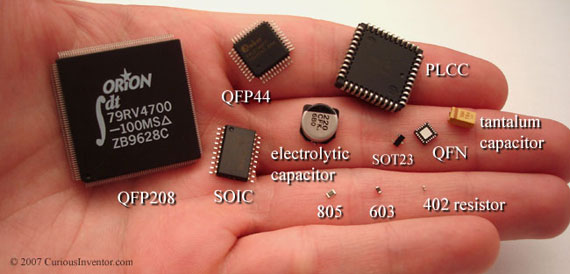Contents and Introduction:
Surface Mount components, as the name suggests, attach to the surface of boards, not through holes like older components. SMDs (“Surface Mount Devices”) are lighter, cheaper, smaller and can be placed closer together. These factors, among others, mean that the days are numbered for through-hole components with widely spaced leads.
This set of guides will demonstrate (relatively) inexpensive tools and methods for soldering and desoldering SMDs.

- Video: Surface Mount Soldering 101 : A 9 min. video showing the basics of SMT soldering and desoldering without expensive equipment. Includes soldering of a 603 resistor, a PLCC, a 44 pin QFP and a fine-pitch, 208 pin QFP, as well as desoldering with ChipQuik®, and prototyping with SchmartBoards®.
- Tools for Surface Mount Soldering : Pictures and descriptions of relatively inexpensive tools needed to solder anything from resistors, to fine-pitch QFPs, to leadless QFNs.
- Soldering a 1206 Surface Mount Resistor: A tutorial on soldering a 1206 resistor. These techniques can also be used to solder other small devices, such as capacitors, MELFs, SOTs, DPAKs, etc.
- Soldering a PLCC: A tutorial for soldering a PLCC (Plastic Leaded Chip Carrier). These steps will work for any package with J-leads, also.
- Soldering two QFPs: a 44 Pin and a 208 Pin Fine Pitch QFP: A tutorial showing how to solder a .8mm QFP (Quad Flat Package) and a 208 pin, fine-pitch QFP.
- Soldering a QFN (Leadless Package) by Hand: (Now with video) QFN (Quad Flat No-Lead) Packages are tricky because the connections are actually on the bottom of the chip, including a heat sink in the very middle. This guide covers techniques for soldering these chips by hand without a stencil, paste or reflow oven. Relatively inexpensive equipment is used, also.
- Paste and Toaster Oven Experimentation: This guide describes our first foray into using paste and toaster ovens to solder a double sided board with fine pitch components. We try out two types of ovens, review a toaster oven controller, and give a step-by-step process overview.
